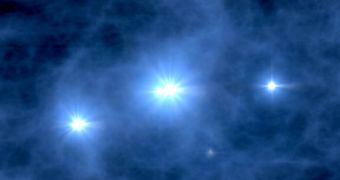The Dark Ages, as we call the period of time between the Big Bang event and the birth of the first star in the universe, is one of the most debated topics in Cosmology, and one of the most unexplored periods in the history of the universe. All this will hopefully change in the near future with the design of the next-generation of telescopes, able to peer back into the past nearly 100 million years after the universe came to be. The Dark Ages Lunar Interferometer is just one of the projects undertaken by the Naval Research Laboratory, as part of the Decadal Survey.
The Decadal Survey, as its name partially suggests, represents an effort amongst astronomers and physicists spanning over a period of two years, in order to establish the new directions to be followed in astronomy and astrophysics. The most likely location for the build of the DALI will be the Moon. As we all know, the universe has not always been as we view it today, filled with stars, planets and galaxies. Shortly after the Big Bang, the universe suffered a rapid expansion which was followed by the so-called Dark Ages, a period of time in which the universe mostly consisted of a uniform mix of charged elementary particles.
Eventually, the 'plasma' cooled enough to allow the formation of hydrogen atoms, which in turn bundled into massive clouds of molecular gas and collapsed to form the first stars, Population I. Still, today most of the ordinary matter in the universe is in the form of hydrogen atoms, continuously being processed inside stars through nuclear fusion reactions.
However, hydrogen gas can also produce radio emissions in the 21-centimeter wavelength of the electromagnetic spectrum, meaning that astronomers can practically probe how the universe and the first stars began to form and study its evolution in time. As the universe is ever expanding, electromagnetic radiation is shifted towards longer wavelengths, the so-called redshift. Although routinely used in various applications around the world, these particular radio emissions are a few million times less bright, becoming extremely difficult to detect, especially while considering that the upper layers of Earth's atmosphere distort these signals beyond recognition.
The solution is to place a telescope in space, and not just anywhere, but on the Moon. During the span of two years, NRL researchers will investigate and design antennas capable of detecting the hydrogen radio emission originating from the Dark Ages, but also to survive the harsh environment of the Moon. Upon completion, DALI should become the most powerful radio telescope ever built, and will be located on the side seen from Earth.
Dr. Joseph Lazio of NRL says that: "Probing the Dark Ages presents the opportunity to watch the young Universe evolve. Just as current cosmological studies have both fascinated and surprised us, I anticipate that DALI will lead both to increased understanding of the Universe and unexpected discoveries."

 14 DAY TRIAL //
14 DAY TRIAL //